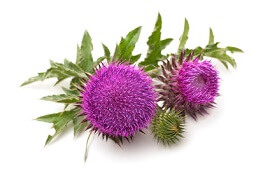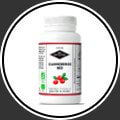Main properties and uses of milk thistle
Milk thistle is recognized for its purifying and protective properties of the liver and gallbladder. It prevents and helps treat certain diseases such as hepatitis, cirrhosis or gallstones, or even certain poisonings by substances toxic to the liver or medications.
Milk thistle also acts on digestive disorders (dyspepsia), mainly those linked to hepatic and biliary disorders. Finally, it has antioxidant and hypertensive properties.
Main uses of milk thistle:
- Liver problems, tired liver:

- Hepatitis, cirrhosis:

- Mild liver failure:

- Jaundice (jaundice):

- Biliary disorders (gallstones):

- Digestive disorders (dyspepsia, constipation, nausea, slow digestion):

Secondary Uses of Milk Thistle:
- Chronic or orthostatic hypotension:

- In addition to certain heavy treatments (chemotherapy, triple therapy):

- Liver poisoning, excess medication:

Different forms of using milk thistle:
Although the capsule remains the most practical form, milk thistle can be consumed in various other forms:
- Powder: 2 times a day in a little water before meals
- Infusion and decoction: boil water and let the milk thistle infuse for a few minutes
- Tincture: dilute in a glass of water

Milk Thistle ID Card
- Botanical name:
Silybum marianum - Synonyms:
milk of our lady, silver thistle
- Family :
asteraceae - Part used:
seed
- Harvest time:
summer - Geographic origin :
Poland
-
Milk thistle, the liver's best ally:
Milk thistle is known for its hepatoprotective properties (protection and regeneration of liver cells). These properties are due to an active substance, silymarin, a flavonoid concentrated in the seeds of milk thistle. This substance is recognized by Commission E (an interdisciplinary panel of recognized experts in medicine, toxicology, pharmacology, phytotherapy and pharmacy) for its protective action on the liver. Sylimarin acts on liver cells, protecting them from toxic substances (alcohol, drugs, toxic plants, etc.) and regenerating them. This is why milk thistle is effective in mitigating the effects of certain serious illnesses, such as hepatitis or cirrhosis, but also in cases of jaundice (jaundice) or steatosis (liver damage, due to a diet too rich in fats or excessive alcohol consumption). Milk thistle can also purify the liver in cases of heavy metal intoxication, medications or poisoning. A treatment based on sylimarin is, for example, given to people poisoned by amanita phalloides (a poisonous mushroom). -
Milk thistle against biliary disorders:
Bile is a liquid produced by the liver, partly stored in the gallbladder, which regulates and promotes digestion, mainly that of lipids. It has a regulation and detoxification function, in case of excess (alcohol, medications, too rich diet). Dysfunction of the biliary system and retention of bile in the gallbladder can lead to gallstones or jaundice. Milk thistle can regulate bile production, and act for the prevention and treatment of gallstones and jaundice.
-
Milk thistle against digestive disorders (dyspepsia):
Dyspepsia generally corresponds to a feeling of discomfort felt in the upper part of the digestive tract (esophagus, stomach) without there being any particular abnormalities in it. It can result in various symptoms such as bloating, discomfort, pain, belching, nausea, etc. Milk thistle is part of several pharmaceutical preparations aimed at treating dyspepsia of hepatic or biliary origin. Commission E and the WHO (World Health Organization) recognize the virtues of milk thistle in cases of dyspepsia. Likewise, the European Medicines Agency considers the use of milk thistle to be effective for “relieving digestive disorders of hepatic origin”, as a two-week treatment. The plant can be consumed in cases of occasional digestive disorders (meals that are too rich, etc.) or chronic.

The most interesting synergies based on milk thistle
In order to optimize the effects of milk thistle, it is possible, or even recommended, to combine it with other plants, essential oils or natural active ingredients. Here you will find some advice depending on the problem concerned:-
Liver and biliary disorders:

Plants: artichoke, black radish (draining, hepatic detoxifiers), dandelion (biliary problems, detoxification), desmodium (stimulates hepatic drainage)
Essential oils: rosemary with verbenone (treatment of liver disorders), carrot (against liver disorders)
Other active ingredients: pumpkin seed oil (cleansing effect on the liver and colon) -
Digestive disorders :

Plants: turmeric (against digestive disorders), ginger (against difficult digestion, nausea)
Essential oils: peppermint (against indigestion, nausea), tea tree (against gastroenteritis), etragon (digestion, antispasmodic), exotic basil (antispasmodic, digestive)
Other active ingredients: Vegetable charcoal (against bloating, reflux, sourness)
Precautions for use and contraindications of milk thistle:
This information is not exhaustive!! Always also consult the instructions on the product packaging as well as the manufacturer's recommendations. If in doubt, consult a health professional.
People allergic to plants in the Asteraceae family should avoid consuming milk thistle. As milk thistle has depurative properties, it can reduce the effectiveness of certain medications: it is always necessary to consult a doctor's advice in the event of treatment. Milk thistle is contraindicated for people suffering from bile duct obstruction as it stimulates bile secretion.
- Keep out of reach of young children.
- Not recommended for children, pregnant or breastfeeding women.
- Use reserved for adults.
- This product cannot replace a varied diet and a healthy lifestyle.
- Do not exceed the recommended daily dose.
Interactions to consider with milk thistle:
Since silymarin has effects on glycemia (blood sugar level), it could interact with other plants acting on blood sugar. Also be careful if you are taking medication for diabetes. Talk to your doctor.
Milk thistle may modulate the activity of certain liver enzymes that metabolize medications. It could therefore increase or decrease the effectiveness of certain medications even if in the majority of cases, these interactions are negligible.

Milk thistle and liver disorders
Since ancient times, milk thistle has been used for diseases related to the liver and bile. This is why European health authorities recognize the traditional use of the plant for liver and biliary disorders. Likewise, in 2004, the World Health Organization recognized the effectiveness of milk thistle in the “complementary treatment of acute and chronic hepatitis caused by alcohol abuse, certain medications and toxic substances”
According to Rudolf Weiss, phytotherapist, the plant acts by regenerating liver cells, which would reduce the effects of certain diseases, toxic products or medications.
However, scientific studies proving the beneficial effects of milk thistle on liver disorders are lacking. However, they recognize the virtues of sylimarin: “it acts as an antioxidant, reducing the production of free radicals, has antifibrotic activity and can act as a toxin blocking agent, by inhibiting toxins on cellular receptors in the liver » indicates a 2010 study published in Phytotherapy research.
Likewise, a 2015 study published in AntiCancer Drugs recognizes "the role of sylimarin as a chemopreventive and therapeutic treatment in cases of hepatocarcinoma (primary liver cancer)", while indicating the need for further research into these effects.
Finally, a 2010 study shows that sylimarin “inhibits the hepatitis C virus and also shows an antioxidant, anti-inflammatory effect and an immuno-modulatory action which contributes to its hepatoprotective effect”.
Bibliography of this study: Weiss Rudolf, “Herbal Medicine”, 2nd edition, 2000. World Health Organization. WHO Monographs on Selected Medicinal Plants, vol. 2, Switzerland, 2002. Milk thistle in liver diseases: past, present, future. Abenavoli L, Capasso R, Milic N, Capasso F. Phytother Res. 2010 Oct;24(10):1423-32. Mastron JK, Siveen KS, Sethi G, Bishayee A. Silymarin and hepatocellular carcinoma: a systematic, comprehensive and critical review. Anticancer Drugs. 2015 Jun;26(5):475-86. Stephen J Polyak, Chihiro Morishima, Volker Lohmann, Sampa Pal, David YW Lee, e, Yanze Liu, eTyler N. Graf, f and Nicholas H. Oberlies, Identification of hepatoprotective flavonolignans from silymarin, Proceedings of the National Academy of Sciences, March 30, 2010; 107(13): 5995-5999.
Milk thistle and biliary disorders
In the United States, every year, 500,000 people undergo surgery to remove gallstones. Their appearance is mainly due to a diet too rich in fats and animal proteins. Several studies have shown that milk thistle is effective in preventing and treating gallstones. Indeed, the plant helps to promote the flow of bile and reduces the cholesterol present in it, thus reducing the appearance of gallstones (which are mainly composed of crystallized cholesterol).
In his article Milk thistle: the natural protector of the liver, Michael Castleman indicates that a low-cholesterol diet, combined with taking milk thistle extract, helped prevent the appearance of gallstones. “In one study, patients with gallstones were given 420 mg of sylimarin. Without a change in diet, after several weeks, they showed a significant reduction in their cholesterol concentration in their bile, which minimized the risk of stone formation.
Bibliography of this study: Murray Michael ND, The Healing Power of Herbs, Rocklin, CA, 1995, p. 248. Castleman, Michael: Milk Thistle: Nature's Liver Protector, http://www.herballegacy.com/McCorrie_Chemical.html
Conclusion and professional opinion:
Milk thistle is recommended in cases of liver and biliary disorders: its hepatoprotective properties have long been recognized in European societies, and validated by health authorities. Its active ingredient, sylimarin, allows the regeneration of liver cells, and thus acts in the prevention and treatment of certain liver and gallbladder diseases.
Its antioxidant and depurative properties also play a role in the treatment of digestive disorders. Although its use for liver and biliary disorders is recognized by specialists, there is still a lack of reference studies to support its therapeutic effects.
The data summarized here is given for information purposes and cannot engage our responsibility.
For further information on use, instructions for use, precautions to take and uses advised against, please refer to the commercial data sheet and label of your products. The food supplements described here are natural plant-based products. However, they are not without danger and without possible interactions with other medications or treatments. It is therefore very important to respect the recommended doses and to tell your doctor or pharmacist that you are taking these products: only he or she will be able to determine if any interactions exist between the food supplement and another treatment or medication that you may be taking.
The pathologies cited in this article are illnesses that can be serious or even life-threatening. A visit to a doctor remains essential. Only he will be able to make a precise diagnosis and, if necessary, provide you with the most appropriate treatment.
Bibliography
- Complete Monographs of the German Commission E - Therapeutic Guide to Medicinal Plants, American Botanical Council, 1998
- Murray Michael ND, The Healing Power of Herbs, Rocklin, CA, 1995, p. 248.
- Castleman, Michael: Milk Thistle: Nature's Liver Protector, http://www.herballegacy.com/McCorrie_Chemical.html
- Weiss Rudolf, “Herbal Medicine”, 2nd edition, 2000
- Guide to healing plants, Vidal, 2010
- World Health Organization. WHO monographs on selected medicinal plants, vol. 2, Switzerland, 2002.
- Festy D. My bible of essential oils Ed. Leduc S 2008
- R. Carducci et coll. (May 1996) Silibinin and acute intoxication to Amanita phalloides. Minerva Anesthesiologica 62 (5): 187–93
- Milk thistle in liver diseases: past, present, future. Abenavoli L, Capasso R, Milic N, Capasso F. Phytother Res. 2010 Oct;24(10):1423-32.
- Mastron JK, Siveen KS, Sethi G, Bishayee A. Silymarin and hepatocellular carcinoma: a systematic, comprehensive, and critical review. Anticancer Drugs. 2015 Jun;26(5):475-86
- Stephen J Polyak, Chihiro Morishima, Volker Lohmann, Sampa Pal, David YW Lee, Yanze Liu, eTyler N. Graf and Nicholas H. Oberlies, Identification of hepatoprotective flavonolignans from silymarin, Proceedings of the National Academy of Sciences, March 30, 2001 ; 107(13) : 5995-5999.
NOTE: This article was written by a pharmacist. The data summarized there come from the scientific literature and the references cited above. For medical advice, in the event of specific or prolonged symptoms, please consult your doctor. Only he will be able to make a precise diagnosis and, if necessary, provide you with the most appropriate treatment.
 OUR
OUR